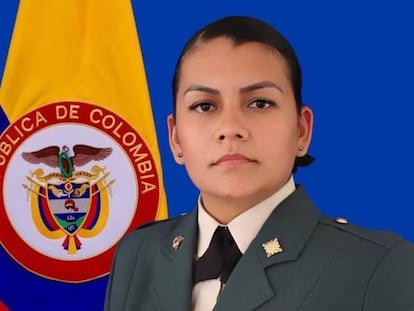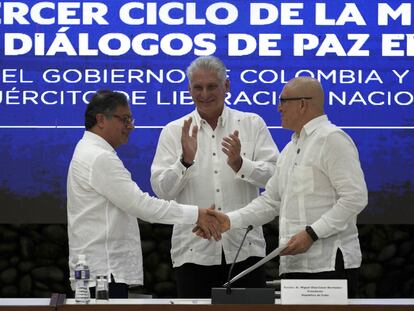The Colombian Army points the finger at the ELN for the kidnapping of a sergeant and her two children
The family disappeared on Monday while traveling through the department of Arauca

On Wednesday, the Colombian Army pointed the finger at the National Liberation Army (ELN) for the kidnapping of a sergeant and her two children in Arauca. “It is presumed that the family was kidnapped by members of the Domingo Laín Sáenz Front of the organized armed group ELN,” reads a statement. According to the Eighth Division, the family was kidnapped on Monday, when they were traveling through Fortul (Arauca) toward the municipality of Arauca in the department of the same name.
“We hold the ELN’s Eastern War Front responsible for the life and physical integrity of our non-commissioned officer and the minors,” reads the press release. In addition, the Army reports that the kidnapped sergeant is Ghislaine Karina Ramirez and that she is a relative of an officer in the Eighth Division. Her two children are six and eight years old; one of them has autism. The armed forces remain cautious about the handling of information. They refer to the few details known about the case as part of an “investigation,” speak in the conditional tense and emphasize that they “preliminarily presume” that they are dealing with a kidnapping.
On Wednesday, the sergeant’s father told Caracol Radio that he had been in contact with his daughter until Monday night. “She wrote me that she was going through the Castilla area, arriving in Yopal, something like that. She told me: ‘It’s bad here. It’s dangerous. The road is isolated. You only see motorcycles. After that, I never heard from her again,” he said. He also said that the sergeant worked in Melgar. “She had not received any threats, as far as I know,” he added.
The kidnapping occurred at a time of uncertainty about how the bilateral ceasefire between the Gustavo Petro administration and the guerrillas will be implemented. On Monday, the ELN announced an armed strike in San Juan (Chocó), a region it disputes with the Gulf Clan. “We’re seeing the start of the agreed-upon ceasefire with the National Government seriously compromised,” a man who identified himself as a member of the Omar Gomez Western War Front said in a recording. The guerrillas then blamed Defense Minister Ivan Velasquez and the military for the Gulf Clan’s actions against the civilian population.
The bilateral ceasefire was signed in Havana in early June. On Tuesday, the armed group gave the order to cease all offensive operations as of June 6, as indicated in the agreement with the government. But the ceasefire will only go into full effect for 180 days as of August 3. There are also conflicting interpretations of the ceasefire’s scope. Hours after the agreement was signed, ELN chief negotiator, Pablo Beltrán, said that civilian kidnappings and extortion are part of the guerrilla group’s funding and that stopping such activities was not included in the dialogues that have taken place so far.
Founded in 1964, the ELN is Colombia’s last active guerrilla group. It has some 2,350 fighters—the number of which doubled during the Iván Duque administration—and it maintains a presence in the departments of Norte de Santander, Arauca, Nariño and Chocó. Negotiating with the group presents several challenges, including fragmented leadership and the emergence of new regional commanders and mid-level cadres who have distanced themselves from past leaders.
Sign up for our weekly newsletter to get more English-language news coverage from EL PAÍS USA Edition
Tu suscripción se está usando en otro dispositivo
¿Quieres añadir otro usuario a tu suscripción?
Si continúas leyendo en este dispositivo, no se podrá leer en el otro.
FlechaTu suscripción se está usando en otro dispositivo y solo puedes acceder a EL PAÍS desde un dispositivo a la vez.
Si quieres compartir tu cuenta, cambia tu suscripción a la modalidad Premium, así podrás añadir otro usuario. Cada uno accederá con su propia cuenta de email, lo que os permitirá personalizar vuestra experiencia en EL PAÍS.
¿Tienes una suscripción de empresa? Accede aquí para contratar más cuentas.
En el caso de no saber quién está usando tu cuenta, te recomendamos cambiar tu contraseña aquí.
Si decides continuar compartiendo tu cuenta, este mensaje se mostrará en tu dispositivo y en el de la otra persona que está usando tu cuenta de forma indefinida, afectando a tu experiencia de lectura. Puedes consultar aquí los términos y condiciones de la suscripción digital.
More information
Archived In
Últimas noticias
All the effects of gentrification in one corner of Mexico’s Colonia Roma
Palestinian reporter Youmna El Sayed: ‘My family told me I had to choose between being a journalist or a mother’
The new language of the workplace: Knowing how to ask AI questions is more important than using it
Russell Tovey: ‘I was advised many times not to come out, I don’t think there was many people who’d done that — and I feel really proud that I’m one of those that did’
Most viewed
- Christian Louboutin: ‘Young people don’t want to be like their parents. And if their parents wear sneakers, they’re going to look for something else’
- The low-cost creative revolution: How technology is making art accessible to everyone
- US sanctions against jailed cartel leader ‘El Marro’ highlight Mexico’s lack of control over its prisons
- Liset Menéndez de la Prida, neuroscientist: ‘It’s not normal to constantly seek pleasure; it’s important to be bored, to be calm’
- Cartels in Mexico take a leap forward with narco-drones: ‘It is criminal groups that are leading the innovation race’











































